
In the hunt for a sweet treat that might appeal to mothers, I started leafing through my mom’s tattered notebook of recipes that I inherited when she died in November 1999. It’s filled with yellowed newspaper clippings, handwritten and typed recipes gleaned from relatives and friends, and lists of dishes served at family holiday celebrations, Hadassah luncheons, bar mitzvahs, weddings, picnics and dinner parties—as much a record of the family’s social life as of culinary exploration.
The first recipe, probably dating from the ‘50s or ‘60s, is for a signature pound cake that she often made, usually with chopped candied ginger or raisins. It’s not very precise—no weights, no pan size, not even an oven temperature. Obviously Mom had all those details in her head.
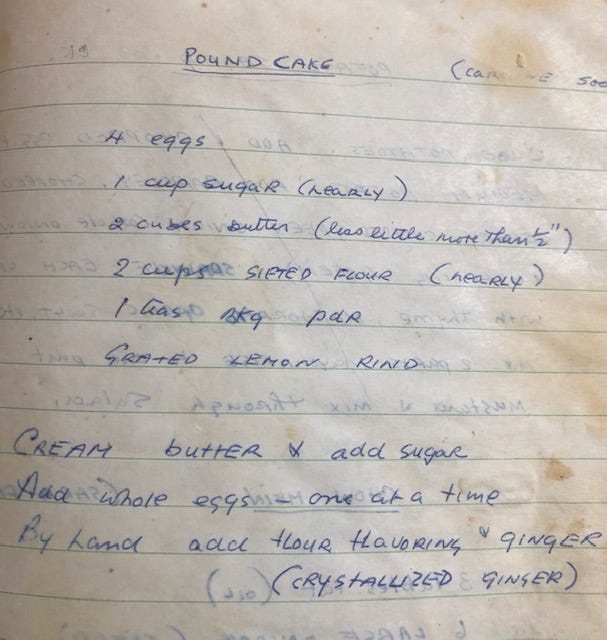
Many of the recipes hold memories for me. The hamantaschen with prune-nut filling calls forth an image of a 5- or 6-year-old curly-headed girl—me!—helping to cut and fill small rounds of flattened dough with stubby little fingers, as Mom supervised, chiding said child for popping more filling in her mouth than in the cookie.
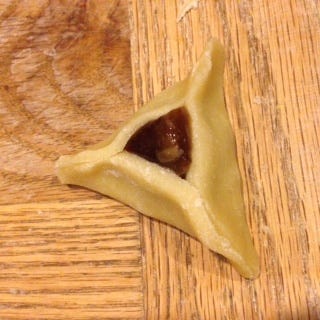
A prune hamantasch ready for the oven. (Check this link for stories and recipes.)
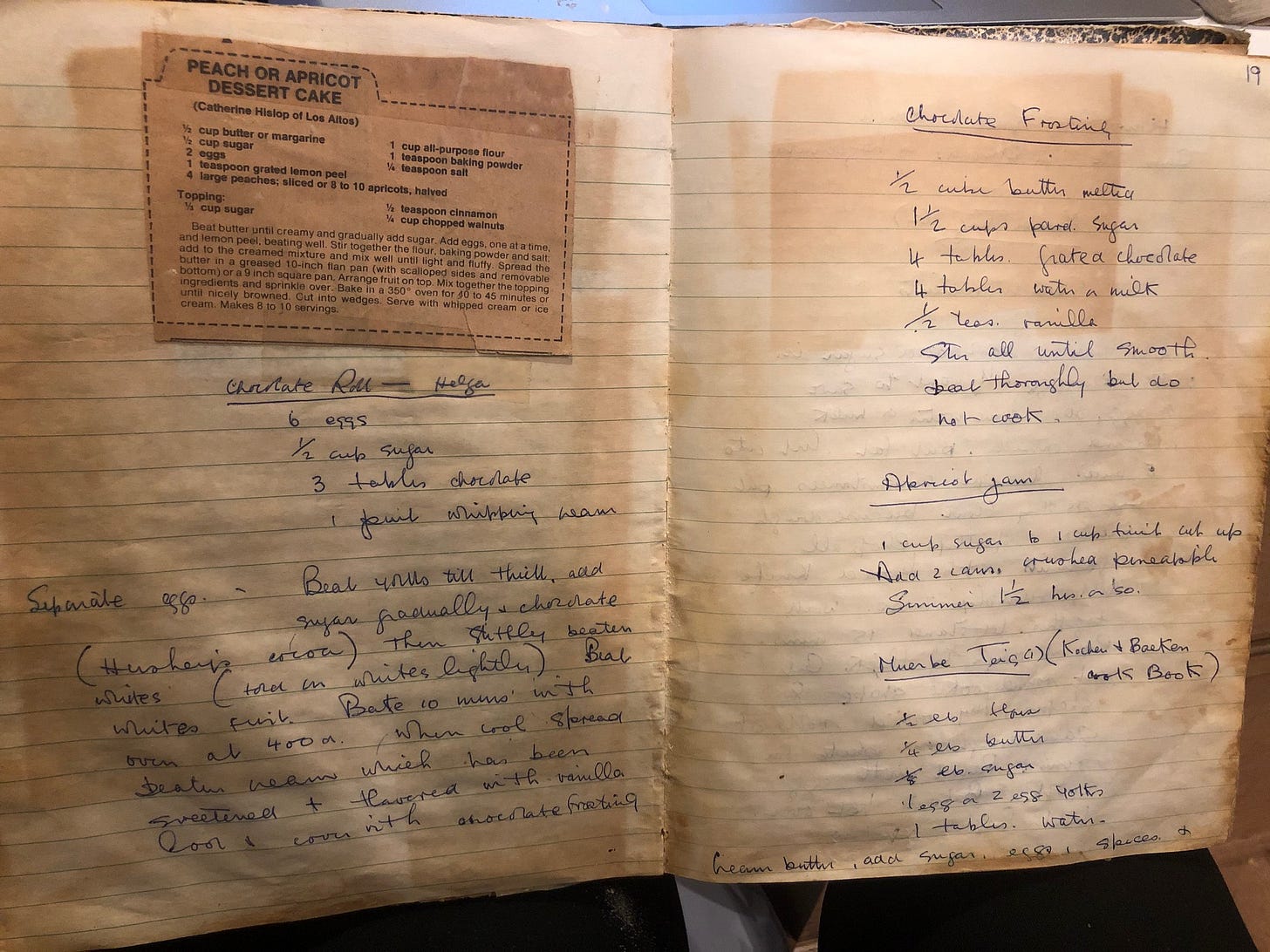
Muerbe Teig recipe, part 1, is on the bottom right.
One recipe that intrigued me and included two versions was called “Muerbe Teig” and hailed from a book of German recipes, Kochen und Backen, (“Cook and Bake”) that my German-born father probably translated for my Scottish mother (though she claimed her knowledge of Yiddish allowed her to understand a good deal of German, especially if she suspected one of my dad’s relations was talking about her). Muerbe Teig, usually spelled Muerbeteig in German cookbooks, or Murbeteig when there’s an umlaut—two dots—over the U, translates to shortcrust. It’s described as “egg pastry” in The Settlement Cookbook, another of Mom’s go-to cookbooks.

My parents, Flora and Vernon Stroud. They met in Glasgow.
My mother, who emigrated with my father to the San Francisco Bay Area from Glasgow following the war (along with my two older brothers, David and Denis), was suddenly far from her Scottish-Jewish roots and surrounded by my father’s large extended German family. She was obviously trying to adjust by cooking what she knew from her very modest beginnings while trying to please her husband, who came from a much more privileged background, by learning to make dishes he loved or remembered from childhood. Her cooking and baking became an interesting mix of Scottish, Eastern European Jewish, German and midcentury American cuisine. Later, after discovering Julia Child’s Mastering the Art of French Cooking, she added a few French techniques and recipes.
Our family might have kippered herring and oatmeal for breakfast, lentil soup with kosher frankfurters and rye bread or challah for lunch, and, for a fancy occasion, Hungarian goulash and spaetzle, or coq au vin. But always there was dessert. It was used as bait to induce the children, four in all, to eat their vegetables. If you wanted Mom’s chocolate chip meringues, butterscotch pudding, almond macaroons, or a dish of ice cream, you’d better clean your plate.
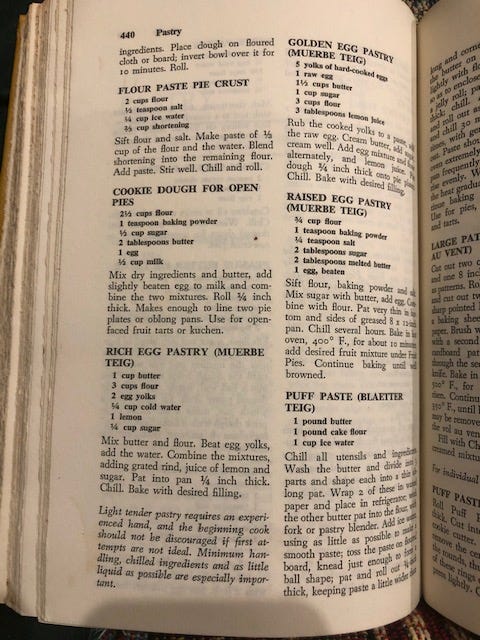
But back to Muerbeteig. When I looked up the recipe in The Settlement Cookbook to reconcile the two handwritten versions in my mother’s notebook, I realized that it wasn’t just my mother who used a shortcrust base for a late summer tart with the plentiful Santa Rosa plums from the backyard tree—it was also my father’s sisters, my aunts Ilse, Gerda and Eva, who used a similar pastry to make the Italian or prune plum tarts that showed up at Rosh Hashanah or break-the-fast family gatherings in September and October. It could also be the simple base for almost any fruit tart and in fact was very similar to the French pâté sucrée. I remembered my mother making pies and tarts—as well as apricot jam— from a productive apricot tree in our first house in Palo Alto.
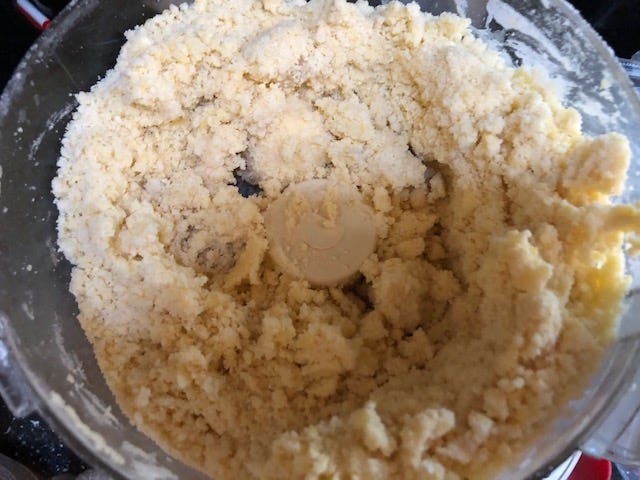
In those days, the crust was always made by hand, cutting the butter into the flour and sugar mix, then adding the egg yolks and liquid, mixing then patting out on a cookie sheet (for a crowd) or in a pie tin for a lesser number of guests. But in the 1980s, food processors were suddenly in fashion—yet another tool for making life less onerous for women (yes, it was still mostly women doing the cooking and baking then)—and it made it quite a bit easier to avoid overworking tart and pie doughs too.
So here it is May, with no apricots or plums in sight yet, but I was thinking that if my mother and aunts were still around, they would love a tart of any kind for Mother’s Day, especially with some Schlagsahne—whipped cream—on top. Luckily, because I’m a bit of a fruit hoarder, I discovered a bag of frozen Empress plums from last October that I decided to make into a tart, along with the last jar of Santa Rosa plum jam I made last summer with farmer’s market bounty. (In today’s era of making do with shopping less, I’m finding frozen, canned and preserved foods to be a godsend! Must be the resurgence of Depression-era frugality!)
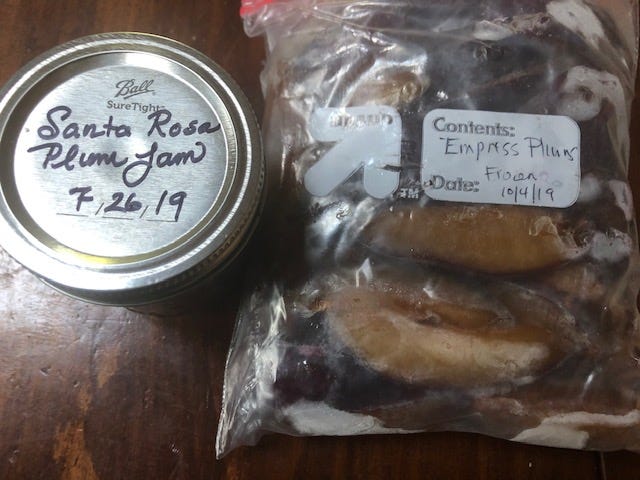
I used a mashup of recipes from The Settlement Cookbook and Joan Nathan’s The Jewish Holiday Cookbook (one of my go-to staples), plus one sent to me some years back by my second cousin Ursula Batz, a wonderful baker, gardener and fount of family history. Ursula told me that she remembered her mother, Elizabeth, my father’s first cousin, whom we all called Liesel, making the plum tart—Tzwechkenkuchen in German—with a yeast dough.

My second cousins, Barbara and Ursula. We share the same great grandparents.
“I make it every year,” Ursula, an octogenarian who lives in the Bay Area with her older sister Barbara, told me. It’s a tradition that her four children love and undoubtedly will pass on to their own children.
Ursula’s recipe for the pastry calls for a quarter cup less butter and a quarter cup more sugar than the one I reference below. I took the proportions suggested in the Settlement recipe, used a food processor to pulse the ingredients together, patted into two 9-inch French tart pans with removable bottoms (also inherited from my mother). I partly defrosted the Empress plums from last fall, and used Joan Nathan’s filling recipe, which calls for a quarter cup of plum preserves, plus a bit of brandy (I substituted a teaspoon of Madeira), spread this on the chilled crust, then covered with the sliced plums in a circular pattern. The dough is enough to make a cookie sheet, as Ursula does for her children and grandchildren for the High Holidays.

Muerbeteig, or Rich Egg Pastry
Ingredients:
1 cup unsalted butter, chilled and chopped in 8-10 cubes
3 cups flour
1/4 cup sugar
1/4 teaspoon salt
2 egg yolks
juice and grated zest of one small lemon
3-4 tablespoons ice water

Directions for making the crust:
Mix flour, sugar and salt together in a medium bowl. Add lemon zest and put in the bowl of a food processor.
Pulse a few times until flour-butter mixture resembles coarse crumbs. Don’t let processor run continuously or it will over-mix the dough.
Add yolks and lemon juice, pulsing a few times just to make sure liquids are incorporated.
Add enough water so the dough holds together, but it won’t be completely smooth.
Divide dough into two equal-sized balls if using 2 tart or pie pans, or leave in single mass if using a cookie sheet.
Pat lightly with fingers to create a crust about 1/4 inch thick that stretches up the sides of tart pan or cookie sheet.
Lightly cover with plastic wrap or wax paper and refrigerate for at least an hour and up to a day. For longer storage, double wrap in plastic and freeze for up to a month.
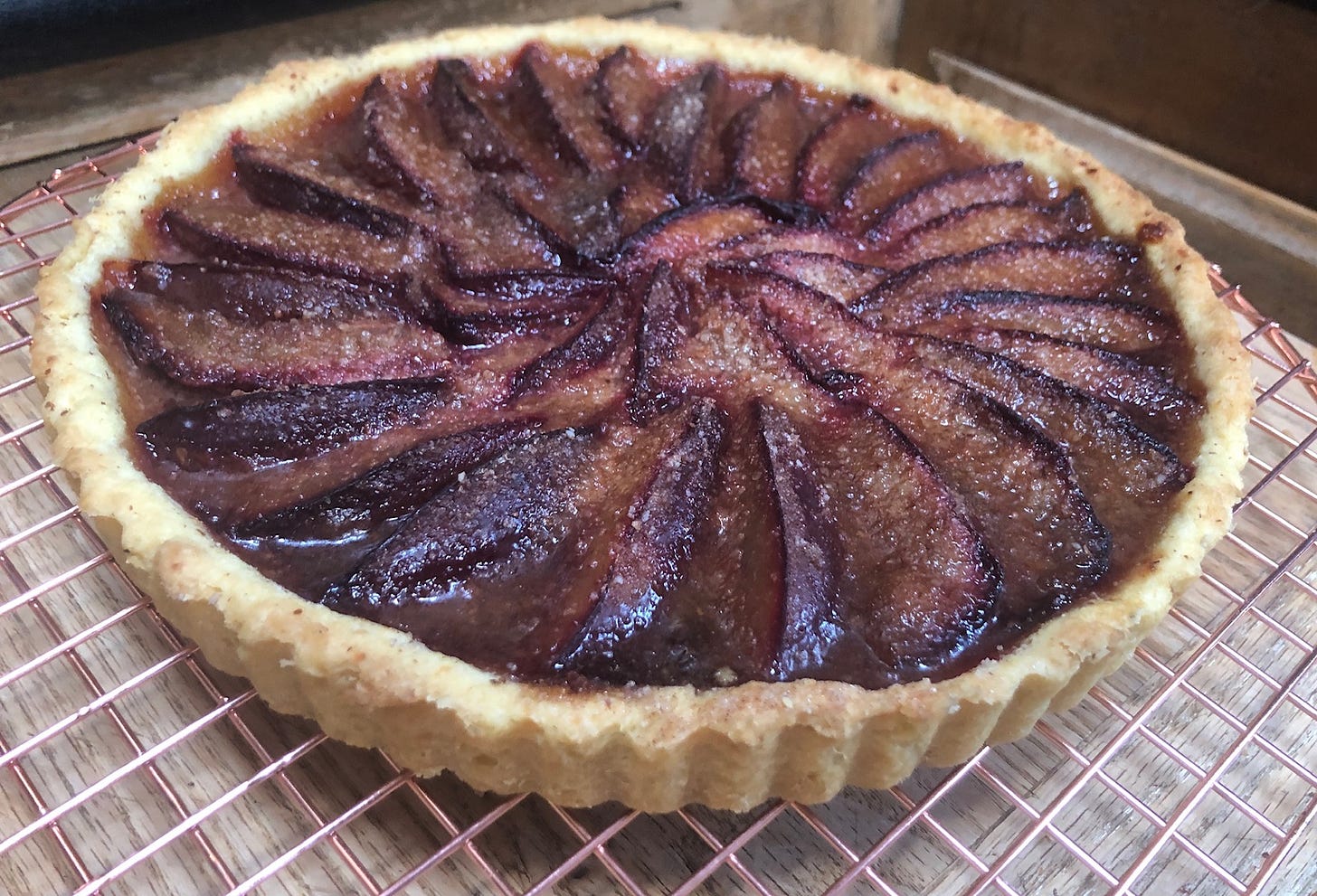
Filling for Plum Tart (Tzwechkenkuchen):
Joan Nathan’s Version (per 9-inch pie)
2 pounds of plums
1/3 cup plum jam
1 tablespoon brandy (I used 1 teaspoon of Madeira)
1/3 cup sugar
1 teaspoon cinnamon
Dash of nutmeg
Grated lemon rind
Directions:
Preheat oven to 375 degrees.
Mix plum jam with a little brandy and spread on the crust. Place the plums in a circle so that each overlaps the other, forming a spiral into the center. (I wasn’t able to achieve this as my plums were a bit too large.)
Mix sugar, cinnamon, nutmeg, and lemon rind. Sprinkle over the plums.
Bake 40-50 minutes, or until the crust is golden brown and the plums juicy.
Notes: I used slightly less sugar and, as my plums had been frozen and released quite a bit of liquid, I dusted the crust with almond flour and added some more on top of the pie. This additional step probably wouldn’t be necessary with fresh fruit, though In Ursula’s recipe (see below), she always dusts the crust with almond flour before filling.

Ursula’s version of plum tart (for two 9-inch pies or a cookie sheet):
Four pounds Italian or French Prunes, sliced in half (stoned), and slit in top of each half.
Sprinkle dough with a thin layer of ground almonds to absorb juices from fruit during baking.
Place prunes in lines across width of cookie sheet, or in concentric circles in pie.
Sprinkle with 1/2 cup sugar combined with 1 teaspoon cinnamon.
Place on middle rack in oven. Bake 45 minutes at 350 degrees, or until dough is golden brown and filling is bubbling.
Variations and Suggestions:
You can make these tarts with apricots, peaches, nectarines, berries, or a mix of fruits.
I also made one pie with apples, using about 4 small granny smiths, each sliced in about 12 wedges. Following a suggestion in The Settlement Cookbook, I sprinkled the fruit with sugar and cinnamon, mixed together 3 tablespoons of cream and one egg yolk, and dripped it around the apples. I baked it at 350 degrees for about 50 minutes until the apples were soft and the crust golden.
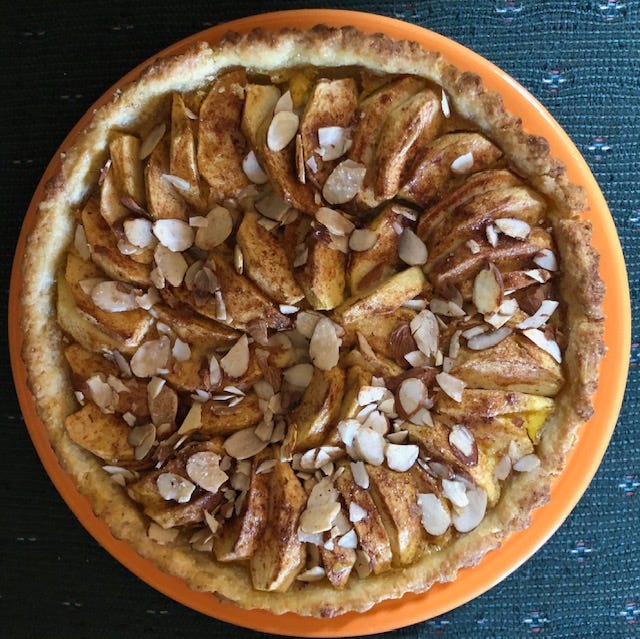
I added a few sliced almonds at the end and baked the pie for another 10 minutes. As apples can release quite a bit of juice, I would suggest sprinkling some ground almonds on the crust before filling—or mix the apple slices with about a teaspoon or two of flour before filling the crust. A dusting of powdered sugar on top of the finished pie adds a bit of panache!

For the mothers in your life, be sure to serve these desserts with a large dollop of whipped cream—or possibly vanilla ice cream. Why not? We’re in the middle of a pandemic. A little decadence is definitely in order!
Thanks for reading my newsletter. If you like it, please share it with a friend, leave a comment, and sign up to receive future posts. You can also find me @ruthtalksfood on Twitter.
See you in the kitchen!

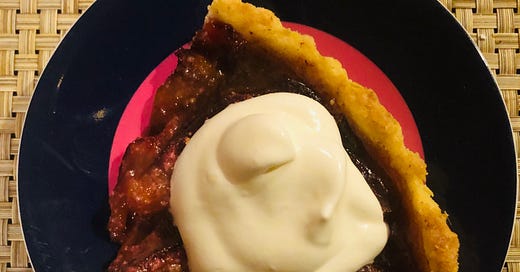

Loved the blog and your presentation tonight. I have the same recipe from my German family. I've made it many times with plums, apricots, and berries. Yum! When this craziness is over I want to bake with you. Happy Mother's Day. ❤️
want to try first . But I know from finding my Grandma's recipes.... what you're doing does take time... Thanks for helping the old recipes not get lost.